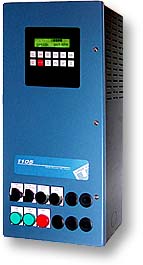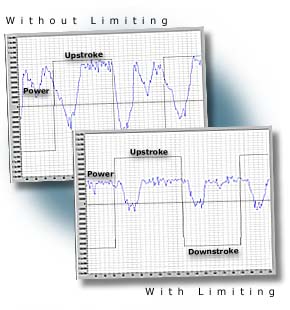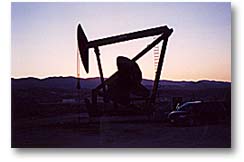Contact us for help in measuring and improving the energy efficiency of your wells.

TECHNICALLY SPEAKING:
 A Benchmark for Assessing the Energy Efficiency of Artificial Lifts
A Benchmark for Assessing the Energy Efficiency of Artificial Lifts
by Christopher Schmidt regional sales manager, western U.S./Canada & Mexico
Electrical energy is often the most significant cost component in the production of oil and gas. Given its importance to the financial performance of a project, it would be useful to have a bench mark for comparing the energy efficiency of a broad variety of wells and artificial lift systems. In these situations, we can use the "perfect system" to create a such a benchmark.
mark for comparing the energy efficiency of a broad variety of wells and artificial lift systems. In these situations, we can use the "perfect system" to create a such a benchmark.
For oil production, we can define the perfect system as one that uses all of the energy it consumes to lift fluid. The benchmark for this perfect system can be expressed as the amount of energy required to lift a given volume of fluid a known distance.
Assuming that the fluid has a density near that of water, we would have an energy consumption of 0.132 kilowatt-hours (kWh) for each barrel of fluid lifted 1,000 feet (see calculation below).
As an example, a 5,000-foot-deep well producing 500 barrels of fluid per day would require a total of 330 kWh of energy per day just to lift the oil. This assumes 100% efficiency.
As a practical matter, power consumption is unlikely to be much less than 500 kWh per day. This would represent an overall efficiency of 66% and a figure of merit of 0.200 kWh per barrel per 1,000 feet. Artificial lift systems with relative energy consumption much higher than that should be investigated for potential improvement.
|
Lift Factor Calculation Assumes a fluid density of 0.0361 lb/in3 Fluid weight Work to Lift Energy consumption = 0.132 kWh/bbl |
|
Lift Factors (kWh/bbl per 1,000 ft) |
|||||
|
API
Specific Gravity |
10 (1.000) |
20 (0.934) |
30 (0.876) |
40 (0.825) |
|
| Efficiency |
100%
|
0.132 | 0.123 | 0.116 | 0.109 |
|
75%
|
0.176 | 0.164 | 0.154 | 0.145 | |
|
50%
|
0.264 | 0.247 | 0.231 | 0.218 | |
|
25%
|
0.528 | 0.493 | 0.463 | 0.436 | |
PRODUCT WATCH:
Space-Saving Option Integrates Operator Devices with Variable-Speed Drives
 Unico offers drives in three configurations—chassis units for mounting in customer-supplied enclosures, NEMA 1 (IP23) units for installation in controlled environments, such as power houses, and NEMA 4 (IP66) packaged units for outdoor environments. Packaged units combine the drive, circuit breaker, and other system components into a single enclosure together with optional door-mounted operator devices such as selector switches, push buttons, indicators, and potentiometers.
Unico offers drives in three configurations—chassis units for mounting in customer-supplied enclosures, NEMA 1 (IP23) units for installation in controlled environments, such as power houses, and NEMA 4 (IP66) packaged units for outdoor environments. Packaged units combine the drive, circuit breaker, and other system components into a single enclosure together with optional door-mounted operator devices such as selector switches, push buttons, indicators, and potentiometers.
A new packaging option for NEMA 1 drives provides similar space-saving simplicity for indoor applications by integrating the operator controls with the drive itself. Often this eliminates the need for a separate control station. As many as 12 operator devices can be mounted directly to the door of the drive enclosure in prepunched holes. Unused holes are sealed with removable plugs.
Operator devices generally interface directly with the drive, which has provision for 12 digital inputs, six digital outputs, three analog inputs, and two analog outputs. Digital I/O can be either 24 V DC or 115 or 230 V AC/DC using plug-in converters. Analog I/O can be configured for 10 V DC or 20 mA operation. All digital and analog I/O points are completely programmable for specific applications using the IEC 1131-compliant programmable logic controller (PLC) resident within the drive.
Contact us to learn more about drive packaging options.
FEATURE FOCUS:
Boost Beam-Pump Efficiency with Power Limiting
 Unico's beam-pump drives incorporate a unique power-limiting feature that can dramatically increase the energy efficiency of a well.Gearbox limiting is just one of many features we've engineered to keep your wells productive. For more information, please contact us.
Unico's beam-pump drives incorporate a unique power-limiting feature that can dramatically increase the energy efficiency of a well.Gearbox limiting is just one of many features we've engineered to keep your wells productive. For more information, please contact us.
By nature, beam pumps have a cyclic power-usage profile that reflects their loading cycle. The power profile of a typical Class III pumping unit, for example, is comprised of two motoring peaks and two regenerative peaks per stroke. Unico's beam-pump software reduces the energy loss resulting from dynamic braking and peak motoring power excursions by clipping the peaks of the power cycle. The user can independently specify the degree of clipping for the motoring and regenerative portions of the cycle. If desired, dynamic braking losses can be eliminated completely by setting the regenerative limit to zero. Best of all, the feature does not affect the well's rate of production.
Power limiting does come with a trade-off, however. Since rod velocity is less tightly regulated during power clipping, there is an increased potential for fluid pound, a condition that can damage pumping equipment. The Unico drive allows the user to determine the balance between system efficiency and equipment protection on a well-by-well basis. If optimal efficiency is the goal, power limiting can be used aggressively. If protecting the pumping unit is a greater concern, power limiting may be used sparingly to make power available for controlling pump velocity, rod load, bridle separation, and the like. Most applications run effectively somewhere in between.
 The charts above show the impact of power limiting on a well at Chevron-Texaco's Cymric site in southern California (right). Power and pump direction are shown before and after power limiting for a Mark II pumping unit running 6 spm on an 8,000-foot well. The speed modulations associated with power limiting reduced both the peak motoring power and the dynamic braking power, lowering the average input power from 40 hp to 34 hp. Pumping efficiency increased 10% from 66% to 76% while the overall pumping speed remained unchanged. Even greater efficiency gains were achievable, but these results represent the best compromise between system protection and power conservation for this well.
The charts above show the impact of power limiting on a well at Chevron-Texaco's Cymric site in southern California (right). Power and pump direction are shown before and after power limiting for a Mark II pumping unit running 6 spm on an 8,000-foot well. The speed modulations associated with power limiting reduced both the peak motoring power and the dynamic braking power, lowering the average input power from 40 hp to 34 hp. Pumping efficiency increased 10% from 66% to 76% while the overall pumping speed remained unchanged. Even greater efficiency gains were achievable, but these results represent the best compromise between system protection and power conservation for this well.
If you'd like to learn more about saving energy with power limiting, please contact us.
WHAT'S COMING UP:
In Future Issues...
Look for the following articles in upcoming issues of Oil & Gas Automation Solutions:
| A comparison of the energy efficiency of sinewave versus six-step drives in ESP applications | |
| Capturing and displaying rod-pump dynamometer graphs with a Palm Pilot | |
| Using a drive to simultaneously display four artificial-lift parameters in real time | |
| A novel way of conceptualizing the effectiveness of artificial lifts | |
| Taking advantage of utility rate structures to reduce artificial-lift energy costs | |
| Power loss components in a typical rod pumping system |
Oil & Gas Automation Solutions is a publication of Unico, Inc. Copyright © 2003 Unico, Inc. All rights reserved.
All trade designations are provided without reference to the rights of their respective owners.
![]() Unico, Inc., 3725 Nicholson Rd., P. O. Box 0505, Franksville, WI 53126-0505
Unico, Inc., 3725 Nicholson Rd., P. O. Box 0505, Franksville, WI 53126-0505
262.886.5678 / 262.504.7396 fax
oilgas@unicous.com / unicous.com